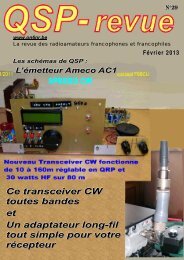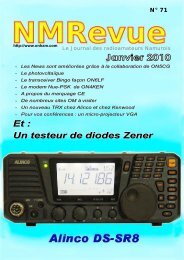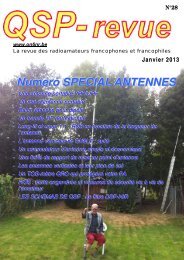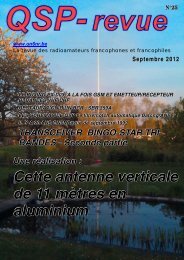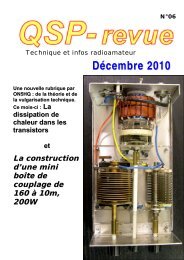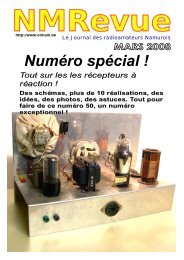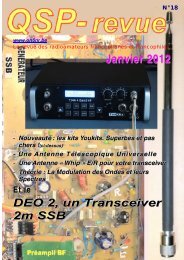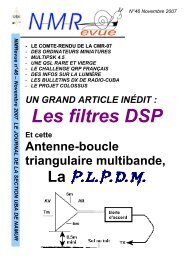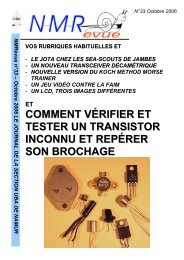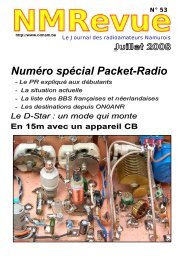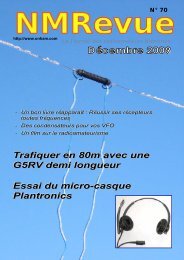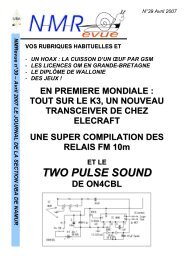Create successful ePaper yourself
Turn your PDF publications into a flip-book with our unique Google optimized e-Paper software.
Les bulletins DX et contests<br />
34<br />
Devant l’intérêt pour cette rubrique, nous l’étendons à la publication du bulletin DX de l’ARRL ainsi qu’aux contests.<br />
ARLP020 Propagation Bulletin<br />
ZCZC AP20<br />
QST de W1AW<br />
Propagation Forecast Bulletin 20 ARLP020<br />
From Tad Cook, K7RA<br />
Seattle, WA May 18, <strong>2012</strong><br />
To all radio amateurs<br />
Look at the archive on http://www.spaceweather.com.<br />
On the upper right side of the page, it is accessed by<br />
selecting a date on the three drop-down fields. Now step<br />
day-by-day through the past week to see the progression<br />
of a considerable number of sunspots. The spots are in<br />
the Daily Sun image on the left side of the page. There<br />
was one new sunspot group on May 10, two on May 11,<br />
four more on May 13, and another on May 15.<br />
Average daily sunspot numbers for the past week rose<br />
nearly 25 points, or about 27%, to 117.3. The big day was<br />
Monday, May 14 when the daily sunspot number jumped<br />
to 156. This was the day after four new sunspot groups,<br />
numbered 1481 through 1484 arrived.<br />
Average daily solar flux rose 12 points to 131, an increase<br />
of 10 percent.<br />
For the near term, predicted solar flux is 135 on May 18-<br />
20, 130 on May 21-22, 125 on May 23, 120 on May 24,<br />
115 on May 25-31, 120 on June 1, 125 on June 2-3, 130 on<br />
June 4, 135 on June 5-9, and 130 on June 10-12.<br />
Projected planetary A index is 15 on May 18, 8 on May 19,<br />
5 on May 20-22, 8 on May 23, 5 on May 24 through June<br />
4, then 8, 12, 18, and 10 on June 5-8, 5 on June 9-11, and 8<br />
on June 12-13.<br />
Check out<br />
http://www.youtube.com/watchv=yJu3a2C5zwo for a<br />
wonderful video of sunspot group 1476 as it transits the<br />
Sun over the week of May 5-11. The images also have a<br />
lovely orchestral accompaniment.<br />
If you plan to be in Washington, DC on June 5, <strong>2012</strong>, you<br />
may want to attend the Space Weather Enterprise Forum<br />
<strong>2012</strong>, held at the National Press Club.<br />
See details at<br />
http://www.nswp.gov/swef/swef_<strong>2012</strong>.html<br />
The "Monster Sunspot" (group 1476) is all over the news,<br />
and on the web as well at http://www.space.com/15736-<br />
monster-sunspot-solar-flare-satellites.html. Be sure to<br />
follow the story all the way down the page below the<br />
video.<br />
A large scale photo of the spot - taken a week ago on May<br />
QSP N°22 <strong>Mai</strong> <strong>2012</strong><br />
11 - is at http://news.discovery.com/space/big-pic-sunspace-weather-sunspot-eruption-120511.html<br />
Don't miss a National Geographic article and photo<br />
gallery on solar activity at<br />
http://ngm.nationalgeographic.com/<strong>2012</strong>/06/solarstorms/ferris-text<br />
Sunspot size comparisons are all the rage this week,<br />
including this article from Universe Today:<br />
http://www.universetoday.com/95232/how-big-aresunspots<br />
Jim Hadlock, K7WA of Seattle, Washington is now in a<br />
limited antenna space, and just uses a couple of 17 meter<br />
mobile whips pointing out horizontally from a center<br />
feedpoint. Jim writes: "It's not that great an antenna - I<br />
often hear west coast stations working DX that I cannot<br />
hear myself. I check the band a couple of times a day for<br />
activity since I'm trying to work 100 DXCC entities this<br />
year (<strong>2012</strong>). Tuesday I worked number 50 (Scotland) and<br />
yesterday around local noon (1718Z) I worked Brunei. In<br />
addition to listening on the band for activity, the NCDXF<br />
Beacons at 18.110 MHz and W1AW at 18.0975 MHz<br />
provide a check on real-time propagation."<br />
If you would like to make a comment or have a tip for our<br />
readers, email the author at, k7ra@arrl.net<br />
For more information concerning radio propagation, see<br />
the ARRL Technical Information Service web page at<br />
http://arrl.org/propagation-of-rf-signals.<br />
For an explanation of the numbers used in this bulletin,<br />
see http://arrl.org/the-sun-the-earth-the-ionosphere.<br />
An archive of past propagation bulletins is at<br />
http://arrl.org/w1aw-bulletins-archive-propagation.<br />
Find more good information and tutorials on propagation<br />
at http://myplace.frontier.com/~k9la/.<br />
Monthly propagation charts between four USA regions<br />
and twelve overseas locations are at<br />
http://arrl.org/propagation.<br />
Instructions for starting or ending email distribution of<br />
ARRL bulletins are at http://arrl.org/bulletins.<br />
Sunspot numbers for May 10 through 16 were 93, 102,<br />
85, 138, 156, 125, and 122, with a mean of 117.3. 10.7 cm<br />
flux was 130.7, 136.4, 129.5, 130.5, 130, 129 and 130.9,<br />
with a mean of 131. Estimated planetary A indices were<br />
12, 12, 10, 12, 6, 5, and 9, with a mean of 9.4. Estimated<br />
mid-latitude A indices were 11, 10, 8, 10, 7, 5, and 8, with<br />
a mean of 8.4.<br />
NNNN



